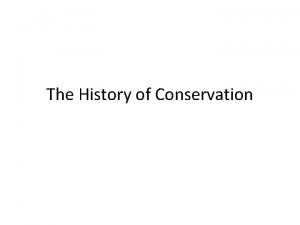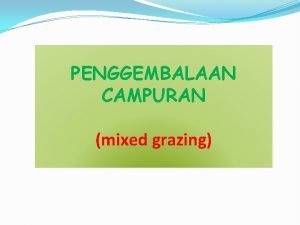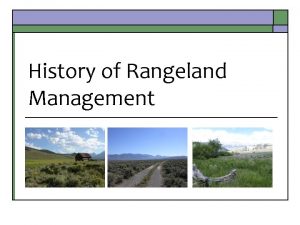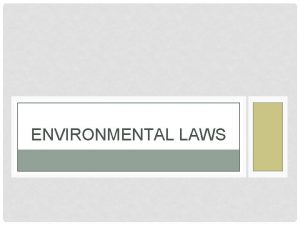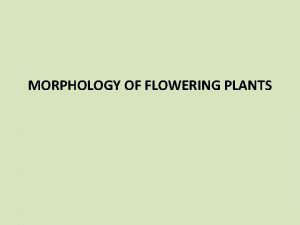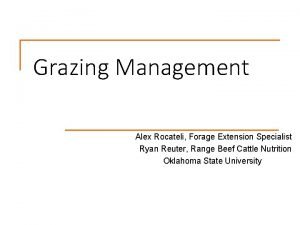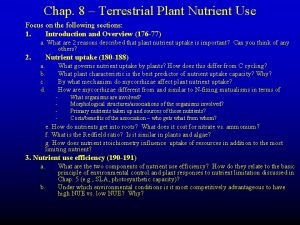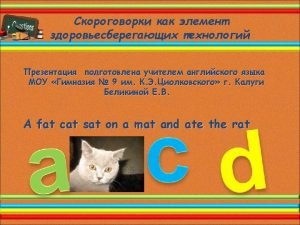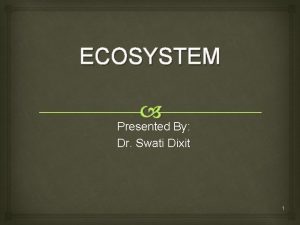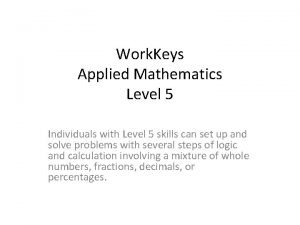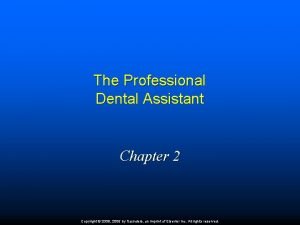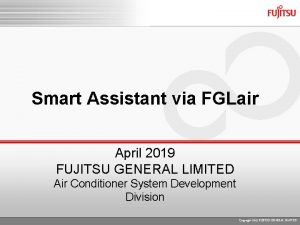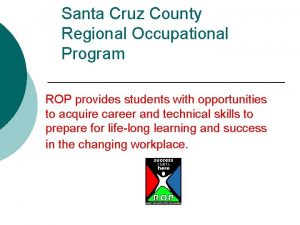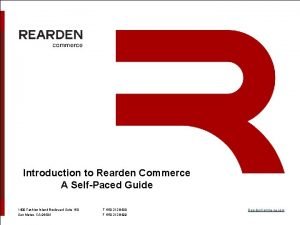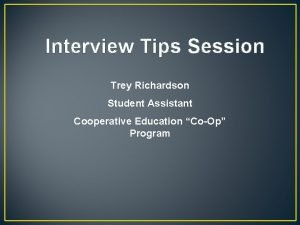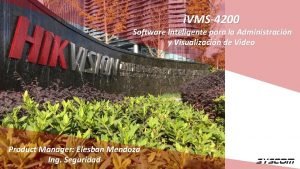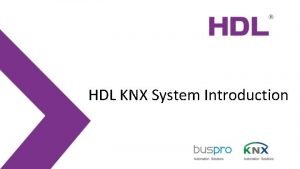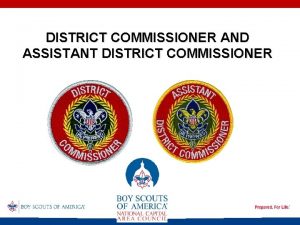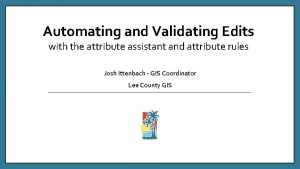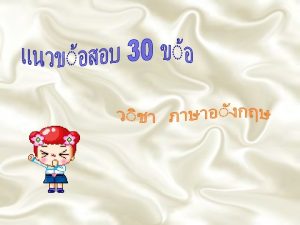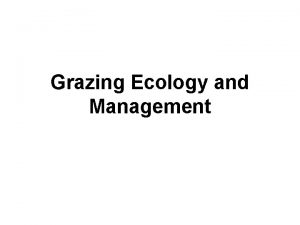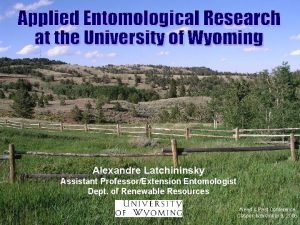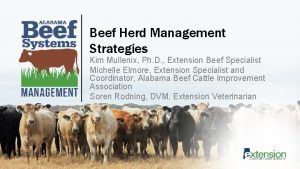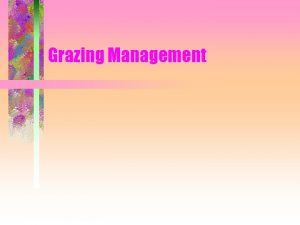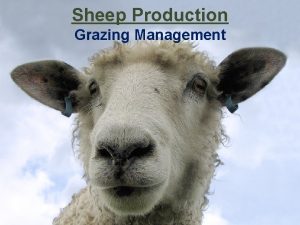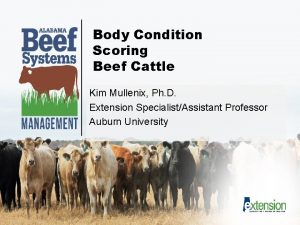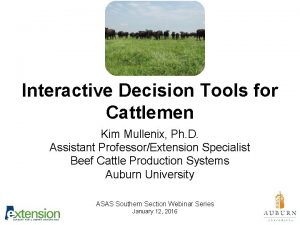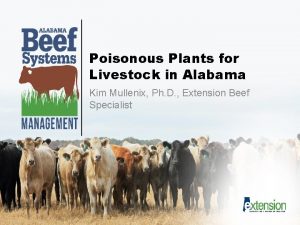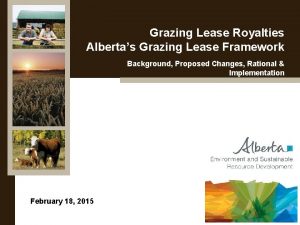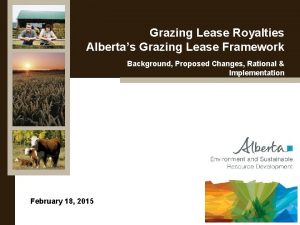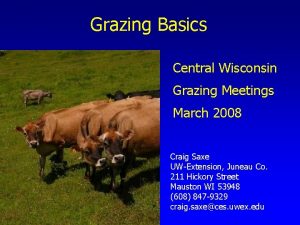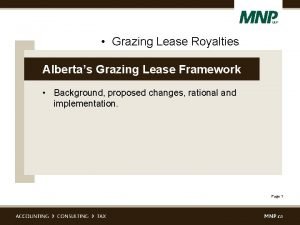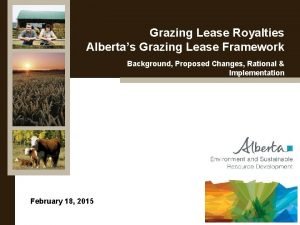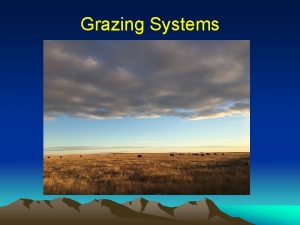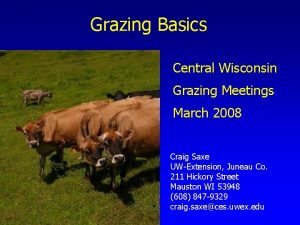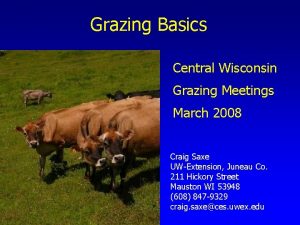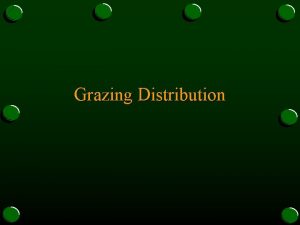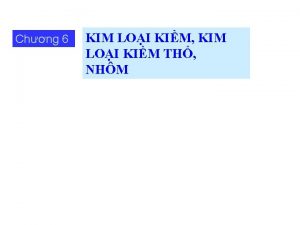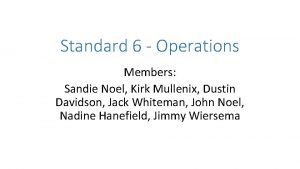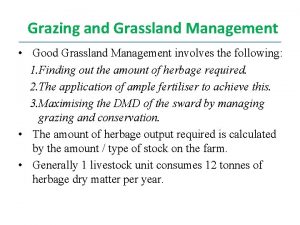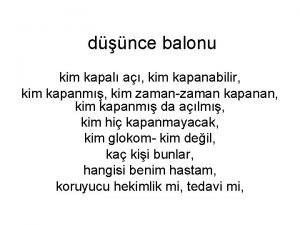Grazing Management Kim Mullenix Ph D Assistant ProfessorExtension






































- Slides: 38

Grazing Management Kim Mullenix, Ph. D. Assistant Professor/Extension Specialist Beef Cattle Systems Auburn University

What is grazing management? • Defined: – The manipulation of the soil-plant-animal complex of grazing land in pursuit of a desired result – The manipulation of grazing in pursuit of a defined set of objectives – Requires labor, capital, land, forage and animal resources

Forages as the Foundation of Grazing Management • Unique from a crop perspective • Why? – Most plants are harvested after a reproductive stage of development – for fruit or seed – Forages are harvested for their leaf area or the “solar panels” of the plant

What makes grazing management different from other crops? • A Unique Job • Continuously or frequently removing leaf area, requiring regrowth throughout the grazing season • Not just “one and done” like row crops • Job Requirements – – Yield Nutritional Value Regrow/Persist* Over Time Help me manage my input costs

Job Requirement - Yield • High forage leaf production over an extended period of time depends on: – Effective light interception and high photosynthetic efficiency – Low extent of leaf aging and decomposition of leaves – Maintenance of a vigorous tiller or shoot population for regrowth – Maintenance of adequate levels of carbohydrates in plant food storage structures

ANIMAL IMPACTS ON PLANTS

Grazing Management – Animal Perspectives • Understanding of what is required by the plants and animals to be productive • How the nutritional requirements of animals can be matched with the ability of the pasture to supply nutrients

Grazing Management - Defoliation • Defined: the removal of plant shoots/leaves by grazing • Effects pasture management depending on: – – – Forage species Selectivity Frequency of grazing Intensity of grazing Stage of development Weather conditions at time of defoliation

Grazing Animals • • Anything that defoliates forage Commonly: cattle, sheep, goats, horses Less frequently: swine and poultry Wildlife: deer, turkeys, insects

Defoliation – Animal Selectivity • Ability to select the highest quality in the sward first • Livestock have preferred plants in the system – “Ice Cream Plants” – These areas are visited the most often • Legumes > Grasses

Defoliation – Animal Selectivity • Livestock prefer less mature plant tissue over stemmy material • Prefer leaves over stems and infloresences specifically • Preferences shift over the grazing season according to 1) plant availability and 2) changing maturity

Defoliation – Animal Selectivity • Cattle and horses– grasses • Sheep – forbs • Goats – browse (shrubs and woody plants)

Defoliation – The effect of forage species • Bunch grasses – Elevate their leaves and growing points higher in the canopy • Low-growth habit grasses – Growing points at the soil surface level or slightly below the soil • Legumes – Buds at the stem tip, crown buds – often where first and new growth comes from

Defoliation - Grazing Intensity • How close to graze • Has the greatest impact on pasture and animal productivity • Indicators of how close to graze: – Grazing height – Stocking rate (number of animals per acre)

Canopy Height and Grazing of Various Forage Crops Crop Begin Grazing (in. ) End Grazing (in. ) Alfalfa 10 to 16 3 to 4 Bahiagrass 6 to 10 1 to 2 Bermudagrass 4 to 8 1 to 2 Clover, white 6 to 8 1 to 3 Dallisgrass 6 to 8 3 to 4 Tall fescue 8 to 12 4 to 8 Annual ryegrass 6 to 12 3 to 4 Small grains (rye, wheat, oats) 8 to 12 3 to 4

Defoliation - Grazing Frequency • How often to graze a pasture area? • Not a set answer! – Can stock pastures continuously – May rotate animals from pasture to pasture – Largely depends on goals, objectives, and resources of the grazier

Defoliation – Weather and Environment • Wet – Hoof action may cause damage to forage crops, cause soil compaction, and reduce water infiltration (dependent on soil type) • Cold – Reduces plant growth, Cool-season grasses 60 to 80°F, Warmseason grasses, 80 to 95°F, Legumes 70 to 90°F • Drought – Reduces plant growth, especially regrowth when grazed – rest period is important here

Grazing Management – Nutrient Distribution • Cattle, sheep and goats recycle nutrients • 70 to 80% of nutrients can be returned to the soil • Significant sources of N, P, and K return – Water, mineral, and shade – areas where animals congregate • Can maximize returns depending on grazing method used, animal stocking rate

Beef heifers grazing bahiagrass pastures – different grazing methods Nutrients concentrated in about 20 to 30% of the total pasture area Source: Vendramini and Sollenberger (2013) Continuous grazing

Grazing Management – Trampling • Pugging – pressure of animal hooves on pasture • Impacts pasture plant response and regrowth • Main considerations: – Number of animals – Grazing tolerance of the plant – regrowth potential – Pasture conditions

Grazing Management - Trampling • Reduces forage utilization • The amount of available forage for grazing • Soil type considerations – Clay soils > silt > sand – Amplified under wet conditions

HOW PLANTS RESPOND TO DEFOLIATION

Understanding Plant Growth – Foundations of Grazing Management Reproductive Vegetative Early growth 90% light interception

Phases of Growth Phase 1 – Slow/transition growth Phase 2 – Vegetative/rapid growth Phase 3 – Reproductive/slow growth

Plant Responses to Defoliation Pounds of DM/acre 35 d 25 d 10 d 0 d Days since defoliation Adapted from Holmes et al. , 2007

Plant Responses to Defoliation – Root Reserves Adapted from Rayburn, 1993 Changes in plant height and carbohydrate energy reserves in a forage plant during regrowth

Impacts of Defoliation on Root Growth Leaf Volume Removed Root Growth Stoppage ---------------------------------- %---------------------------------10 to 40 0 50 2 to 10 60 50 70 78 80 to 90 100 Source: Dietz, 1989

Overgrazing • Allowing animals to regraze plants before they are able to replace root reserves used for regrowth • Three Key Items: – Reduces available leaf area for regrowth – Reduces root reserve carbohydrates – Impacts persistence of forage in stand, leads to species composition changes

Undergrazing • Increasing animal selectivity in pasture systems – Spot-grazing – Decreases total forage utilization • Increasing forage maturity – less nutritive value • Reduced regrowth potential

Plant Responses to Defoliation • Necessary to find a balance between plant growth and potential to maximize animal use – Balance of plant regrowth and persistence • Dependent on stage of growth

Response is largely dependent on plant stage of growth Grasses First Growth Vegetative Leaves only, stems not elongated Stem elongation Stems elongated Boot Infloresence enclosed in flag leaf and not showing Heading Infloresence emerging Anthesis Flowering stage Milk stage Seed immature, endosperm milk Dough stage Well-developed seed, center is doughy Ripe stage Seeds ripe, leaves green to yellow brown

Leaves and Regrowth are Good But Do Not Last Forever • Leaf area is good – increases yield potential • Pasture leaf tissue cannot be stored over long periods of time – leaves live about 30 to 60 days • Aging leaves do not use sunlight as efficiently and eventually die

Figure 2. Changing proportion of dead leaves over time – Ball et al. 2015 Forage Production Total Growth Dead leaves Green forage Leaf Area Units

Maximizing Regrowth • Use management methods to keep forage in rapid growth phase • “Take half leave half” – as a starting point • Understanding the production range of the forage crop being grown

Maximizing Regrowth • Cool-Season Forages – Average yield between 1, 000 to 1, 500 lb DM/acre per harvest to 3, 000 to 3, 500 lb DM/acre

Cool-Season Forages Growth Response Pounds of DM/acre 3500 lb DM/acre 2, 000 lb DM/acre 1, 000 lb DM Days since defoliation Adapted from Holmes et al. , 2007

Use management tools available to maximize forage production • Estimate forage availability in pasture systems • Know the range of production expected of species selected • Understand limitations – environmental, etc. • Use grazing methods to improve utilization

Questions? Visit www. aces. edu/beefsystems The Alabama Cooperative Extension System (Alabama A&M University and Auburn University) is an equal opportunity educator and employer. Everyone is welcome! © 2017 Alabama Cooperative Extension System. All rights reserved.
 Lacey act 1900
Lacey act 1900 Taylor grazing act 1934
Taylor grazing act 1934 Mixed grazing
Mixed grazing Taylor grazing act 1934
Taylor grazing act 1934 Food chain sequence
Food chain sequence Taylor grazing act 1934
Taylor grazing act 1934 In some plants like grass monstera and banyan tree
In some plants like grass monstera and banyan tree Navajo nation grazing permit laws
Navajo nation grazing permit laws Grazing
Grazing Grazing food chain
Grazing food chain He that hatches matches hatches catches
He that hatches matches hatches catches Structure of ecosystem
Structure of ecosystem Tansely
Tansely Office management assistant psc
Office management assistant psc Pyramid levels of management
Pyramid levels of management Management pyramid
Management pyramid Basic concepts of management
Basic concepts of management What are writing conventions
What are writing conventions Workkeys applied mathematics level 5 answers
Workkeys applied mathematics level 5 answers Juliette southard
Juliette southard Fujitsu home assistant
Fujitsu home assistant Rop medical assisting
Rop medical assisting Promotion from assistant to associate professor
Promotion from assistant to associate professor Mia irwan
Mia irwan Cisco sbcs
Cisco sbcs Kpu health care assistant
Kpu health care assistant Rearden commerce
Rearden commerce Interview questions for student assistant
Interview questions for student assistant Ibm support assistant workbench
Ibm support assistant workbench Hikvision recording assistant
Hikvision recording assistant Hdl knx assistant software
Hdl knx assistant software Cuhk salary scale 2020
Cuhk salary scale 2020 Assistant scorer
Assistant scorer Function of district commissioner
Function of district commissioner Smita had been working as an assistant manager
Smita had been working as an assistant manager Cashflow assistant
Cashflow assistant Assistant teacher of gps
Assistant teacher of gps Attribute assistant arcmap
Attribute assistant arcmap Shop assistant good evening what can i do for you
Shop assistant good evening what can i do for you
